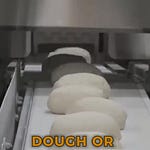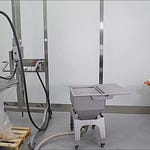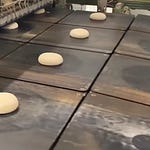Unlike traditional cutting, extrusion forms yeast-raised donuts by pushing dough through ring-shaped dies. This high-speed method eliminates trimming waste and ensures uniform shape.
Dough Preparation and Initial Fermentation
Production begins with mixing enriched dough using high-protein flour, sugar, fats, and yeast. The dough undergoes intensive mechanical mixing to develop a strong gluten network crucial for trapping gas and ensuring the dough's elasticity.
Key technical points include:
Dough hydration should be between 58% and 62%, slightly higher than in traditional sheeting methods, which usually range around 55%. This increased hydration improves flow through the extruder and helps achieve a softer, more extensible dough suitable for ring forming.
Dough temperature is maintained around 26–28°C to facilitate yeast activity.
Gluten development is carefully monitored to ensure the dough achieves an ideal balance of strength and extensibility.
Bulk fermentation typically lasts 60–120 minutes, allowing yeast enzymes to generate CO₂ and ethanol, increasing dough volume and refining texture.
Endogenous enzymes (amylases, proteases) gradually break down starches and proteins, enhancing dough softness and extensibility.
Dough Extrusion and Forming
Here, dough is placed into a hopper and extruded through ring-shaped dies using controlled air pressure or mechanical pistons. This forms precise, uniform donut rings directly onto moving trays.
Critical considerations during extrusion:
Dough viscosity and rheological behavior must be tightly regulated.
Viscosity (dough’s resistance to flow): A dough with high viscosity is thicker and stiffer, making it difficult for the extruder to push it through the ring-shaped die. This can cause inconsistent shapes, mechanical strain, or even blockage.
Rheological behavior (how the dough deforms under stress): Good extrusion dough must exhibit viscoelasticity, it should deform under pressure but still spring back and hold its shape once deposited.
Adjustments to dough formulation, such as slight increases in hydration or addition of dough conditioners like cysteine and emulsifiers) optimize extrusion ease and donut uniformity. For instance:
L-cysteine: Breaks disulfide bonds in gluten proteins, softening the dough and increasing extensibility, allowing the dough to flow more easily through the extruder without tearing or resisting shape.
Emulsifiers: Improve the interaction between water and fat in the dough, enhancing gas retention, dough stability, and softness. They contribute to a finer crumb structure and better volume, and also delay staling.
This extrusion method minimizes waste compared to traditional cutting processes, eliminating dough trimmings and rework. However if the dough is:
Too firm or under-hydrated → It won’t flow well through the die, leading to irregular rings or equipment strain.
Too soft or over-hydrated → It will lose structure immediately after extrusion, resulting in misshaped donuts or collapsing rings.
Proofing Stage
Post-extrusion, donut rings enter proofing chambers at controlled conditions (~38–42°C, high initial humidity). This secondary fermentation phase further inflates the dough, developing the final airy texture.
Yeast fermentation intensifies, further aerating dough.
A controlled humidity profile helps dry the surface slightly toward the end, creating a desirable outer skin, limiting oil uptake during frying.
Frying and Final Product Formation
Proofed donuts are gently fried in vegetable shortening (~190°C) for approximately 1–2 minutes per side. During frying, several simultaneous processes occur:
Rapid moisture evaporation and oil uptake: Water evaporation from the dough surface allows hot oil to replace moisture, achieving a desirable fried taste and texture.
Starch gelatinization and protein denaturation: Heat transforms starches and proteins, setting the internal crumb structure of the donut.
Maillard reactions: Surface browning occurs through reactions between sugars and amino acids, providing characteristic flavor, aroma, and color.
Glazing and Finishing
After frying, donuts are cooled briefly before glazing. Glazing provides a glossy, appealing finish and seals in freshness. Excess glaze is efficiently recovered to maintain sustainability.
👉 Thanks for reading!💬 Any experiences to share with us?? – We’d love to hear your story!
Sources: https://tinyurl.com/3pd7hunf
https://tinyurl.com/yxu9bann











